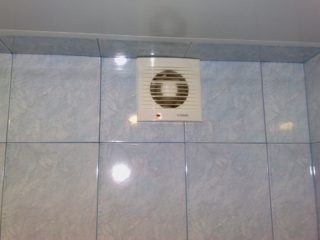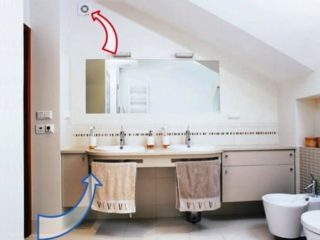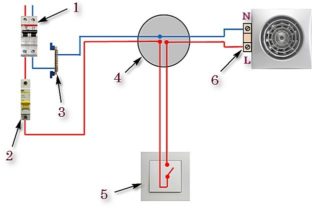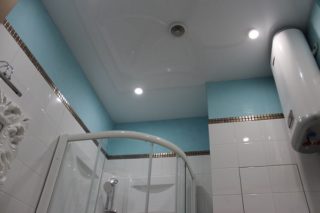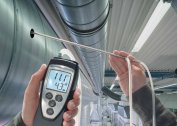The forced exhaust in the bathroom or toilet is powered by electricity, so there must be a wire line connection to the place of its installation. Power is usually supplied through a switch in order to be able to control the operation of the device. You can organize the connection of the fan in different ways, here everyone chooses the most suitable scheme for themselves. In most cases, the task is simplified by combining lighting with a supply and exhaust system. This solution has its advantages and disadvantages.
Rules for choosing an electric fan for a bathroom
There are a lot of exhaust devices on sale, but you cannot take the first device you like, it is important to know its technical characteristics and the conditions in which it will work. In order for the microclimate in the shower room to be in acceptable aisles in accordance with sanitary standards, the following points must be taken into account:
- What power should be the device. This refers to its performance. This parameter directly depends on the area of the room where the hood will be installed.
- Diameter of the seat. In a pre-laid channel, the suction pump itself should fit and freely pass the supply wires;
- Additional features. There are devices with a timer, engine speed control, mechanically closing drapes shutters, motion or lighting sensor.
An important parameter influencing the choice may be the noise of a working installation. If the level of created decibels exceeds the recommended threshold, it will be difficult to operate the electric fan near sleeping rooms.
How to check natural ventilation
If a natural ventilation system is included in the building design, it is possible that it is also not necessary to equip a forced draft. To verify this, it is necessary to check the design for operability. Verification methods are as follows:
- Check traction in the channel. To do this, light a match and bring it to the entrance of the channel. If the flame rushes towards the hole, there is a draft. It is recommended to carry out monitoring in warm, slightly windy weather, when the differential pressure parameters are always at a minimum.
- Analysis of the effectiveness of drying the room. For this purpose, the shower is filled with steam: they open hot water through a diffuser and lower it for some time. Then they look at how abundant water droplets form on the walls of the room and how long it does not dry out.
If the humidity quickly goes away, natural circulation is enough to organize high-quality air exchange in the toilet room or bathroom. Otherwise, it is necessary to put an additional electric fan pump.
Connecting a fan in the bathroom to the switch
An electric fan is not connected directly to the supply line, but via a toggle switch or switch. Usually there is no need for continuous operation, especially in the summer, when you can open the window and ventilate the bathroom. Switches are single, double and multi-key. To organize the operation of an electric motor with an impeller, the first two options are sufficient.
Separate toggle switch for device
The best option would be to install a separate switch on the exhaust pump.
- You can turn on the electric fan at any time and not use it strictly with the light on, as in the version with parallel power from the light bulb.
- When repairing the device, it is easier to disconnect it from the voltage for safety reasons.
It is not always possible to implement such a scheme for connecting to a fan switch if there is decoration in the room, so the wires are laid at the construction stage. A separate switch is an additional cost and you need to find free space for its installation.
There are exhaust electric fans with a built-in toggle switch and a control system in the form of a hanging cord. For such devices, you can only make a line feed.
Connection via single-key switch
If a tile is already laid in the shower room, and it is not possible to remove it, you need to make an electrical supply, you can do just that - take the power from the light bulb, connecting to it in parallel. Then the pump will work simultaneously with the light. Wires can be fed from the lamp through a plastic box.
This option is good from an economic point of view, since there is no need to spend money on an additional switch, the cable will go less. The only drawback here will be the principle of operation - only when the light is on. This is inconvenient, since drafts are felt during bath procedures, sometimes you have to leave light to completely remove wet steam from the room.
Use of a two-gang switch
At the stage of designing the installation of a fan in the bathroom, you can immediately provide a line for powering the appliance from a dual switch, on which lighting will also hang. This is convenient and profitable, since a toggle switch with two keys costs a little more than a single-key and cheaper than two separate switching elements. Otherwise, all the advantages that are inherent in a separate extractor hood power supply also apply here. It is only important to remember which key the line is on, so as not to get confused and not leave light, thinking that it works by blowing.
Powerful wires should not be routed under the exhaust fan, usually the amount of watts consumed by household appliances is small.
Timer fan connection
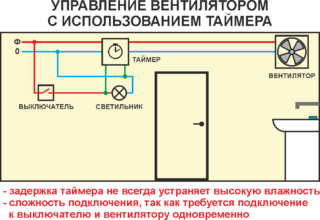 Devices with a built-in timer can function as follows:
Devices with a built-in timer can function as follows:
- Turn on at the moment when the light comes on and stop working after a certain time after turning off the light. The delay in this case can be fixed or custom.
- The engine is started after the lamp has died out.
The latter option is more comfortable, as it relieves residents of the inconvenience in terms of drafts and noise of the operating unit at the time of use of the bathroom or toilet. To implement a draft project with a timer, a three-core cable is needed, where two lines are the supply line and one wire is the signal one.
How to organize air exchange in the shower

The room for the reception of bath procedures must be equipped with forced-air and exhaust ventilation, there are several reasons for this:
- This is a zone of high humidity, which in itself cannot be dried with a simple heater;
- In bathrooms, in most cases there are no windows, which eliminates the possibility of using simple ventilation.
The standard equipment of the exhaust system includes a suction unit and a device for air intake. As the latter, the usual device for the lower part of the interior door can be used - a decorative mesh. Then air exchange will be carried out by connecting the room with other rooms.
If there is no possibility to upgrade the door, the inflow can be arranged at the expense of the supply valve or use a recuperator in the bathroom. In the latter case, one organized channel in the wall will perform two functions at once: intake and air supply. The system can be powered from a separate switch.
When constructing a new building, it is advisable to lay small vents in the upper part of the bathroom and toilet project. This will allow only airing during the summer period.
Electric fan installation
Installing a hood is not a difficult technical event, but still it requires certain skills in the construction industry, or at least an understanding of these processes. The most important thing is to decide on the place where the exhaust pump itself will be placed. According to the rules, this should be the highest point in the area where vapor formation or just a large accumulation of moisture is most likely. If you take a shower or bath, this is directly the area of the tap, in the toilet - a toilet bowl.
Wall mounted
To connect the fan in the bathroom to the wall, do the following:
- Mark on the working plane of the wall a seat under the housing. To do this, a plastic pipe with a diameter slightly larger than the diameter of the seat itself is applied to the tile or concrete, and a circle is drawn.
- Using a diamond crown, they drill a channel in the wall into the street. This can be done with a drill and hammer drill.
- The pipe from the outside is covered with a thin layer of mounting foam-glue and inserted into the resulting channel.
- In order not to remove the tile and bring electricity to the unit, the inter-tile seam is selected and a two-wire flat wire is inserted there, laying it to the place where the light switch is installed. They make switching to it.
- The product is connected to electricity, a layer of liquid nails is applied to the landing panel from the inside and the device is inserted into the ventilation pipe.
Next, turn on the device and check how it works. There should be no extraneous noise and vibration.
You can simplify the process and connect the engine just to the light bulb. To do this, you do not need to ditch the inter-tile seam, it is enough to purchase a plastic box in which an electrician is laid. The box itself is glued to the tile, leading it to the lamp. Next, the cable is connected to the cartridge and laid to the exhaust pump.
